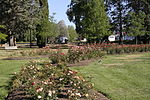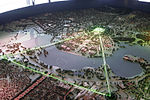Aboriginal Tent Embassy

The Aboriginal Tent Embassy is a permanent protest occupation site as a focus for representing the political rights of Aboriginal Australians and Torres Strait Islander people. Established on 26 January (Australia Day) 1972, and celebrating its 50th anniversary in 2022, it is the longest continuous protest for Indigenous land rights in the world. First established in 1972 under a beach umbrella as a protest against the McMahon government's approach to Indigenous Australian land rights, the Aboriginal Tent Embassy is made up of signs and tents. Since 1992 it has been located on the lawn opposite Old Parliament House in Canberra, the Australian capital. It is not considered an official embassy by the Australian Government. The Embassy has been a site of protest and support for grassroots campaigns for the recognition of Indigenous land rights in Australia, Aboriginal deaths in custody, self-determination, and Indigenous sovereignty.
Excerpt from the Wikipedia article Aboriginal Tent Embassy (License: CC BY-SA 3.0, Authors, Images).Aboriginal Tent Embassy
King George Terrace, Canberra Parkes
Geographical coordinates (GPS) Address Nearby Places Show on map
Geographical coordinates (GPS)
| Latitude | Longitude |
|---|---|
| N -35.301111111111 ° | E 149.13 ° |
Address
King George V memorial
King George Terrace
2600 Canberra, Parkes
Australia
Open on Google Maps











